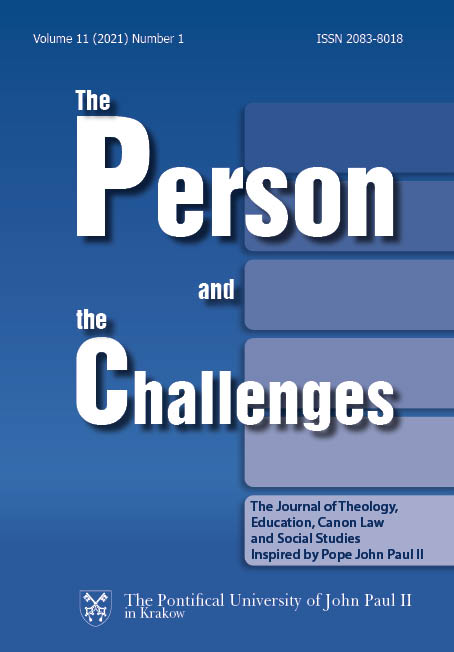Association between one’s attachment to parents and subsequent attachment to a partner
DOI:
https://doi.org/10.15633/pch.3890Keywords:
Attachment, child, partner, father, motherAbstract
The primary purpose of this study was to explore the association between individuals’ attachments to their mothers and fathers, and their subsequent attachments to partners, based on research conducted in Slovenia. Participants in the empirical study were antenuptial couples who attended the premarital counselling course organized by and offered through the Franciscan Family Institute in Ljubljana, Slovenia. In order to explore more fully the concept of attachment, the authors of the study focused on the following dimensions: trust, communication and estrangement. The results of the study showed greater similarities in the three identified dimensions to the way in which both women and men experience attachment to their mothers and partners, while there were marked differences in the subjects’ experience of attachment to their fathers.
References
Armsden G., Greenberg M.,The Inventory of Parent and Peer Attachment: Relationship to well-being in adolescence. Journal of Youth and Adolescence 16 (1987) 5, pp. 427–454.
Belsky J., Fearon R. M., Precursors of attachment security, in: J. Cassidy, P.R.Shaver (eds.), Handbook of attachment: Theory, research and clinical applications, 2008, pp. 295–316.
Blatt S., Blass R., Relatedness and self-definition: A dialectic model of Personality Development, New Jersey 1996: Lawrence Erlbaum Associates.
Bowlby J., Attachment. Attachment and loss, New York 1969: Basic Books.
Bowlby J., Attachment. Attachment and loss. Attachment, 2ed. New York 1982: Basic Books.
Bradshaw J., The Family: A revolutionary way of selfdiscovery, Florida 1988: Health communications inc.
Brajša Žganec A., Emotional Life of the Family: Parental Meta-Emotions, Children’s Temperament and Internalising and Externalising Problems, »Društvena istraživanja« 23 (2014) 1, pp. 25–45.
Cohen J., Statistical Power Analysis for the Behavioral Sciences (2nd Ed) LEA, 1988.
Cvetek R., Predelava disfunkcionalno shranjenih stresnih izkušenj ter metoda desenzitacije in ponovne predelave z očesnim gibanjem, Dissertation, University of Ljubljana, 2004.
Erzar T., Kompan Erzar L.K., Teorija navezanosti, Celje 2011: Celjska Mohorjeva družba.
Field A., Discovering Statistics using IBM SPSS Statistics (4th Ed), London 2013, SAGE.
Gostečnik C., Poskusiva znova, Ljubljana 2001: Brat Frančišek in Frančiškanski družinski inštitut.
Gostečnik C., So res vsega krivi starši?, Ljubljana 2014: Brat Frančišek in Frančiškanski družinski inštitut.
Gostečnik C., Cvetek R., Pate T., Poljak Lukek S., Simonič B., Valenta T., Repič Slavič T., The impact of early aggression on late development, »The Person and the Challenges« 9 (2019) 2, pp. 169–192.
Izard C., On the Development of Emotions and Emotion-Cognitive Relationships in Infancy. The Development of Affect. New York 1978: Plenum Press.
Kompan Erzar L.K., Skrita moč družine, Ljubljana 2003: Brat Frančišek in Frančiškanski družinski inštitut.
Kompan Erzar L.K., Ljubezen umije spomin, Ljubljana 2006: Brat Frančišek in Frančiškanski družinski inštitut.
Kompan Erzar L.K., Erzar T., Teorija navezanosti, Celje 2011: Celjska Mohorjeva družba.
Kuhar M, Jeznik K., Effects of group discussion attachment styles and facilitation on the quality of deliberation, »Društvena istraživanja« 27 (2018) 2, pp. 281–303.
Mikulincer M., Shaver P.R., Attachment in adulthood: Structure, dynamics and change, NY 2010: Guilford Press.
Mitchell S., Relational concepts in Psychoanalysis, Harvard 1988: University Press.
Puhar A., Prvotno besedilo življenja, Studia Humanitatis 2004.
Rothschild B., The body remembers: The psychophysiology of trauma and trauma treatment. New York 2000: WW Norton&Compani.
Rotschild B., The body remembers casebook: Unifing methods and models in the treatment of trauma and PTSD, New York 2003: W.W. Norton&Compani.
Rotschild B., Help for the helper: The psychophysiology of compassion fatigue and vicarious trauma, New York 2006: W.W. Norton&Compani.
Schore A., Affect Disregulation and disorder of the Self, New York Norton 2003: W.W. Norton.
Simonič B., Empathic parenting and child development, »The Person and the Challenges« 5 (2015) 2, pp. 109–121.
Stern D., The interpersonal world of the infant, Camridge 1985: Harvard University press.
Stern D., The present moment in psychotherapy and everyday life, New York 2004: W.W. Norton&Company.
Van der Kolk B., Treating Trauma Survivors with PTSD, Washington, DC 2002: American Psychiatric Press, Inc.
Xie X., Mulej Bratec S., Schmid G., Meng C., Doll A., Wohlschager A., Finke K., Forstl H., Zimmer C., Pekrun R., Schilbach L., Riedl V., Sorg C., How do you make me feel better? Social cognitive emotion regulation and the default mode network, »Neuroimage« 134 (2016), pp. 270–280.
Downloads
Published
Issue
Section
License
Authors who publish with this journal agree to the following terms:
- Authors retain the copyright and full publishing rights without restrictions, and grant the journal right of first publication with the work simultaneously licensed under a Creative Commons Attribution 4.0 International License that allows others to share the work with an acknowledgement of the work's authorship and initial publication in this journal.
- Authors are able to enter into separate, additional contractual arrangements for the non-exclusive distribution of the journal's published version of the work (e.g., post it to an institutional repository or publish it in a book), with an acknowledgement of its initial publication in this journal.
- Authors are permitted and encouraged to post their work online (e.g., in institutional repositories or on their website) prior to and during the submission process, as it can lead to productive exchanges, as well as earlier and greater citation of published work (See The Effect of Open Access).

